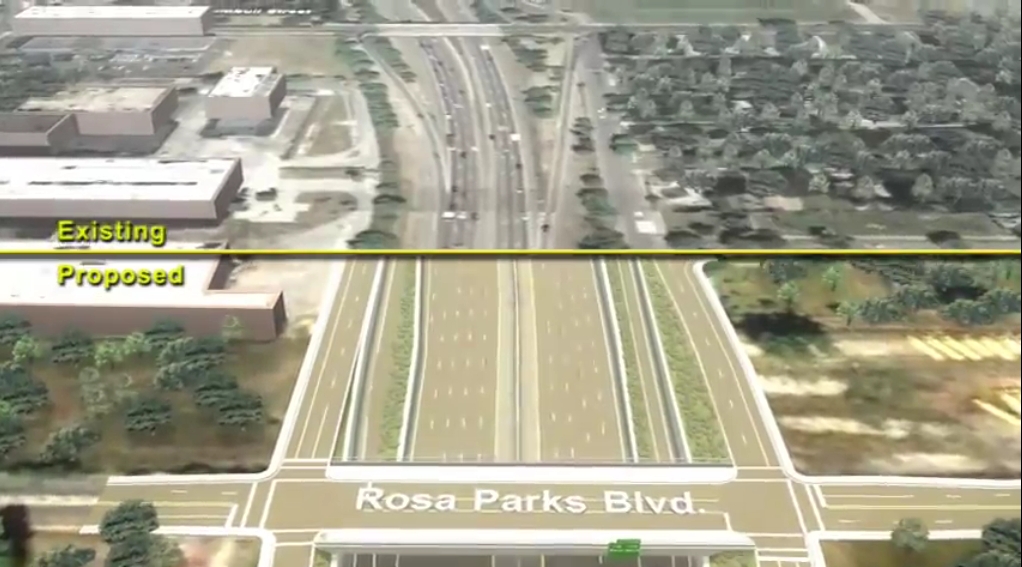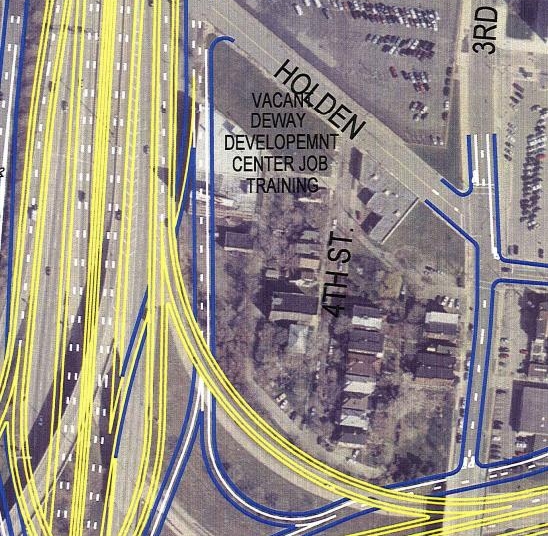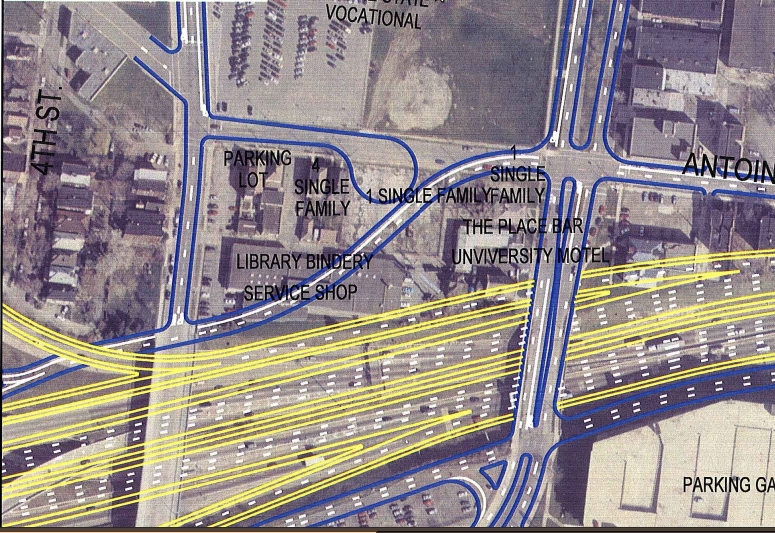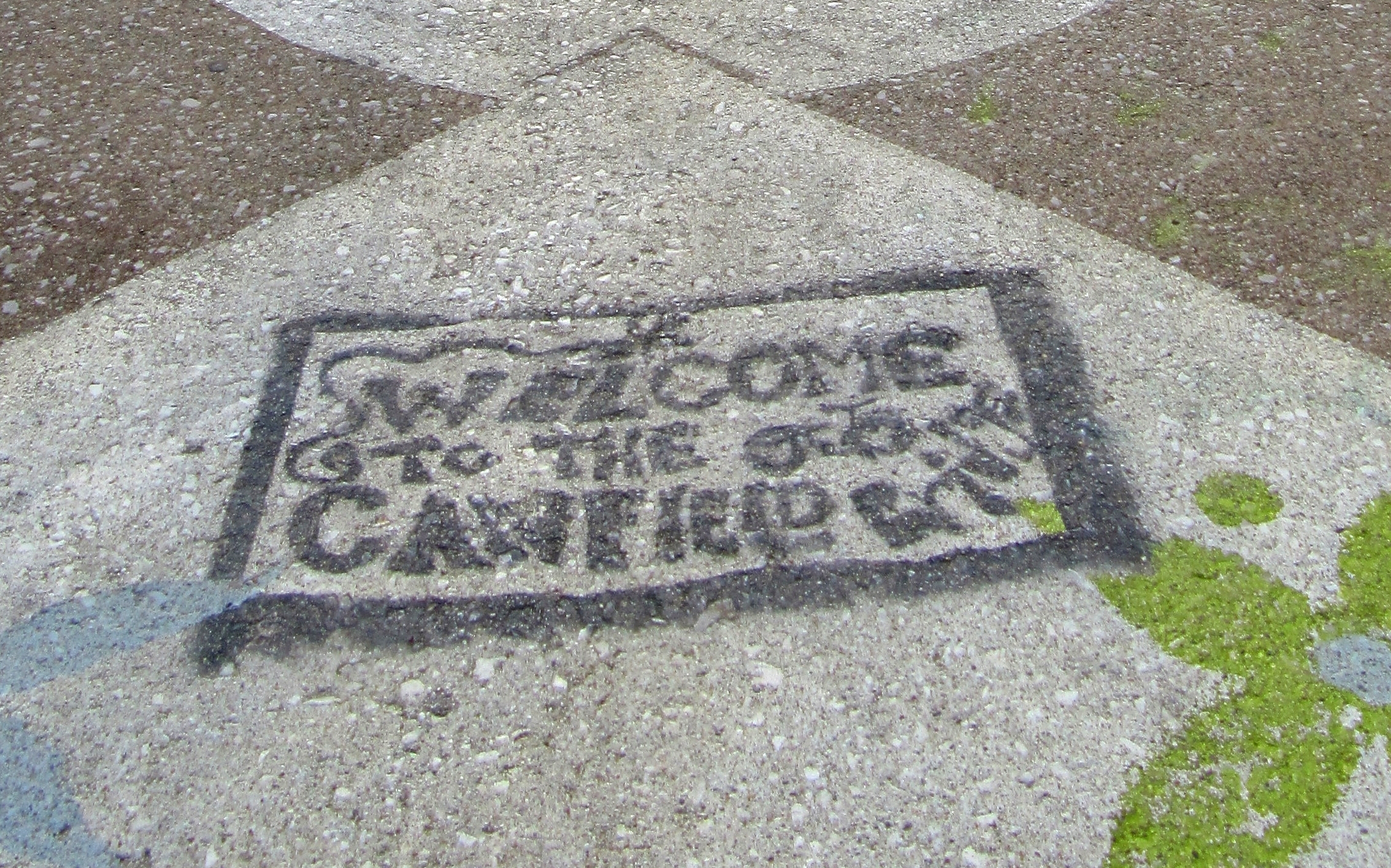
An expanding I-94, including new service drives and on- and off-ramps, approaches Detroit's Woodbridge neighborhood. Video: MDOT
The Michigan Department of Transportation will be breaking ground this year on a $1.3 billion project to significantly widen I-94 between I-96 and Conner Avenue in Detroit.
Watch the video: buildings, railroad rights-of-way, and pedestrian bridges will vanish before your eyes (sorry, no explosions or cool sound effects) as the Ford Expressway fattens itself to as many as eighteen lanes in width. Details of the project can be found in MDOT’s I-94 Rehabilitation Project Final Environmental Impact Statement and Section 4(f) Evaluation (FEIS, for short).
Although the decade-long planning process concluded with a handful of public meetings in 2001 and 2003, many Detroiters are only now becoming aware of the highway’s expansion and are beginning to ask questions about how the project will affect their communities. For a document that was supposedly created to analyze the impact of the highway’s proposed expansion, the FEIS utterly fails to provide clear answers to such relevant questions as Will my house be demolished? Will my kids have to move to a different school? or How will traffic flow in my neighborhood be impacted?
I will do my best to provide answers to these and other questions below. But first, some background:
Is This Really Necessary?
The I-94 expansion is supposedly intended to reduce congestion and increase safety along the highway. It is debatable, however, if this benefit would ever be realized. The FEIS ignores the phenomenon of induced demand, by which motorists quickly consume any newly-generated highway capacity simply by taking more frequent, or longer, trips. Adding concrete to our urban centers only encourages people to move further away from work, shopping, and entertainment, increasing rather than reducing traffic and congestion. Urban planners figured this out over a decade ago, and expressways in many cities around the world are being scaled back or eliminated altogether, often resulting in an increased quality of life for everyone in the region – not to mention a huge savings in tax dollars.
It’s not the 1990s anymore. Automobile use is becoming increasingly unattractive as gas prices (which often dipped below a dollar per gallon while the I-94 expansion was being planned) are now pushing four dollars per gallon and don’t show any signs of decreasing. Telecommuting is on the rise. A younger generation of working Americans is electing en masse to live closer to downtown employment centers, and residential development in downtown Detroit is progressing steadily even in the midst of a nationwide housing collapse. Funding is in place for both commuter rail and bus rapid transit in southeast Michigan.
It was the lack of consideration given to truly multimodal, transit-oriented solutions that prompted Transportation Riders United, a Detroit transit advocacy group, to write a scathing 53-page response to MDOT’s draft Environmental Impact Statement. As TRU points out, the Southeast Michigan Council of Governments 2020 land use projections (upon which the demand for an expanded I-94 was foretasted) used a model which assumed sole reliance on the automobile. TRU cites the Federal Highway Administration and Federal Transit Administration, who, in a 2000 review of SEMCOG’s methods, criticized regional authorities for lacking “operational mode choice or transit network assignment models for the region, [without which] the ability to … analyze tradeoffs among transit alternatives and between transit and highway projects is extremely limited.”
TRU also challenges many of MDOT’s dubious and unsubstantiated claims regarding supposed positive side effects of the project. According to FEIS Chapter 5: Social, Economic, and Environmental Impacts, the expansion of I-94 will bring about an increase in property values and property tax revenues in the vicinity of the highway (somehow), enhance pedestrian and bicyclist mobility (never mind that nine bridges over the highway will be removed without replacement), improve aesthetics within the I-94 corridor (if you like the way freeways look), and create construction jobs (but so would an equal investment in mass transit).
Adverse Impacts
Perhaps the most significant impacts of the planned expansion will come not from the widening of the highway itself, but from the addition of two-lane service drives and wider freeway on- and off-ramps. Although MDOT often makes the claim that the service drives will increase “neighborhood connectivity” and “pedestrian and bicycle mobility,” local traffic flow parallel to the expressway never seems to have been a problem. Crossing the expressway, on the other hand, is presently a challenge in many areas and will only get worse: current bridges across I-94 are not long enough to span the widened expressway, and while some of these will be replaced with longer bridges, many will be eliminated without replacement.

The creation of additional service drives will eliminate green space in Detroit's Fourth Street neighborhood and necessitate the demolition of the "Deway Development Center" -- now a highly successful charter school. Image: MDOT
Prior to the publication of MDOT’s FEIS, a number of public and private entities and individuals were given a chance to comment on on a draft version. No letters of unqualified support arrived, and many entities asked for, or provided, clarification on the adverse impacts of an I-94 expansion. The Environmental Protection Agency, for example, criticized MDOT’s assertion that the project would improve pedestrian and cyclist mobility, describing the issue as “difficult to objectively assess because there is little data presented … that discusses the existing pedestrian access.” According to the EPA, “[the project would] combine vehicular bridges with pedestrian bridges and eliminate stand-alone pedestrian bridges [without consideration of] how these changes would impact pedestrian and bicycle activity in the area.” The City of Detroit’s Planning and Development Department concurred that “pedestrian mobility will be seriously restricted” and recommended that MDOT “[e]xplore the feasibility of a scaling back [the project] … creating funding that could be used for potential mass transit” and pointed out recent changes in federal funding priorities that increased the viability of mass transit alternatives to highway expansion. Detroit’s City Planning Commission held a public hearing on the MDOT project and reported “all non-MDOT speakers had serious concerns about the project.” The CPC and Detroit City Council also opposed the gratuitous taking of residential and commercial properties for expanded expressway service drives.

The Third Street bridge, which provides access to Wayne State University and the Fourth Street neighborhood, will be eliminated and several buildings will be demolished to make room for new service drives. Image: MDOT
Perhaps the strongest and most significant local government opposition to the MDOT project came from the City of Ferndale, located six miles north of I-94 and thus removed from any immediate adverse impacts. The City Manager and City Council of the suburban community described the expansion as “too large, too costly, not coordinated with any regional mass transit plan … a detriment to regional and community development.” A resolution from Ferndale’s City Council lamented a plan that would, in its view, “aggravate urban sprawl, disinvestment from the central city and its older suburbs, and does nothing to help those who may not have private transportation options.”
Organizations such as the Michigan Land Use Institute, the Mackinac Chapter of the Sierra Club, the League of Women Voters, and the Michigan Lung Association also spoke out against the project, characterizing MDOT’s FEIS as a lopsided account that exaggerated positive effects of the project while downplaying or obfuscating negative ones.
(All quotations in the preceding section are taken from FEIS Chapter 8: Public Participation and Agency Coordination)
Property Acquisition and Building Demolition
As the document is supposed to describe the impact of a construction project, one might expect the FEIS to provide a concise and readable description or list of properties and public infrastructure to be demolished or otherwise taken. This is not so. The FEIS does, however, provide a series of aerial photographs, upon which are superimposed depictions of the planned expressway, service drive, and interchange routing. With a significant amount of cross-referencing and eyeball strain, the following lists were generated (reading from west to east):
Pedestrian-only Bridges to be Removed Without Replacement
Brooklyn over I-94
Canfield over M-10
Pedestrian/Automobile Bridges to be Removed Without Replacement
Third over I-94
John R over I-94
Beaubien over I-94
Lucky over I-94
E Ferry over I-75
Piquette over I-75
Saginaw over I-94
Eastbound Harper over I-94
McClellan over I-94
Buildings to be Demolished
5287 Hecla: house*
957 Holden: University Preparatory Academy (partial demolition only)
5820 Third: Detroit Public Library Service Shops
5840 Second: United Sound Systems Recording Studios*
5832 Second: house
467 Antionette: house
447 Antionette: house
6060 Rivard: Quality Storage
6001 Russell: Sterling Truck Sales
5845 Russell industrial building
6000 Russell: Square D/Detroit Fuse and Manufacturing Company*
1550 Trombly: storage building
9305-9315 Gratiot: Vigilante’s Detroit Motorcycle Club
Undeveloped Parcels to Be Acquired (No Demolition)
5511 John C. Lodge: lot behind McCoy Townhouses
899 W Baltimore
6141 Third: parking lot
617-657 Antionette: parking lot
459 Antionette
435 Antionette
5847 Cass
991 Harper
5930 Hastings
994 Harper
6411 Mt. Elliot
9317 Gratiot
(asterisks indicate National Register of Historic Places listed or eligible properties)
According to page 5-20 of the FEIS, “displacement numbers are approximate and based on conceptual design … final design, final determination of impacts to residences and businesses, and coordination with residents will determine the actual acquisitions and displacements.”
I Don’t Like This! What Do I Do?
According to MDOT’s Frequently Asked Questions page, the project “must be built as shown and approved in the [F]EIS … the project footprint shown in the [F]EIS cannot be changed. This includes pavement widths, access points and bridge locations, as well as any major changes to the right of way acquisition.”
Although, as we know all too well (um, Woodward Light Rail?), just because a major infrastructure project has been proposed, planned, and funded does not mean that it will ever actually be built. According to MDOT, construction will commence this summer with repairs and reconstruction of existing bridges. Details, however, have not been released.
Project-specific questions may be directed to Bill Shreck, MDOT Office of Communications, at 989-754-0878, extension 227. Otherwise, contact your Michigan Representative and Senator as well as (especially if you are a Detroit resident) all nine City Council members. Also, it can’t hurt to talk to a representative of any neighborhood-based community organization you may be a part of, such as a block club or the ever-expanding Midtown Detroit, Inc.










Upon reading your title, my first thought was, “Wow, how anachronistic!”
MDOT spent more time and money developing a theme for this expressway segment than they did analyzing its impact on other modes of transportation. MDOT’s suggested themes included jazz and the Underground Railroad. They thought putting a saxophone or oil lamp in stamped concrete would make it all better.
Thanks for your work on this post. When I first heard about this project I was astonished. It is just mind-boggling that it got approved. Meanwhile, the Governor wants to go hat in hand back to the voters for more $ for roads, DDOT is essentially bankrupt, and SMART has been cut to the bone.
Do you have a URL to an MDOT page or other official announcement that says that the construction on I-94 is starting this year? I can’t find anything on their website on the I-94 Rehabilitation Project newer than 2010 where they were discussing designs for bridges, noise walls, and vegetation.
I’ve known about this project for years, but the last that I heard is that they didn’t have funding to start work just yet.
Could also try getting a construction timetable from project manager Terry Stepanski at 517-241-0233.